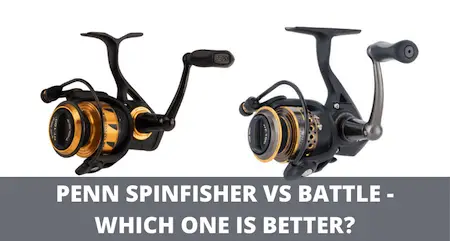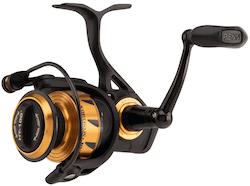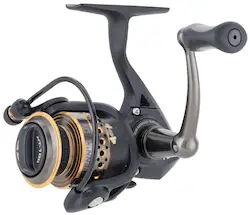Penn Battle Vs Spinfisher Reels – What Are The Differences, And Which One Should You Buy?
UPDATED 14 MAY 2023
by Robert Ceran
This article may contain affiliate links. If you make a purchase after clicking on a link we may earn a small commission at no extra cost to you.
If you’re currently on the look out for a new Penn saltwater reel, then two of their most popular lineups are the Spinfisher VI and Battle III series.
Both of these lineups make excellent saltwater reels. So what makes them different from each other, and which one is best for your purpose?
My team and I tested the most important features of the Penn Battle vs Spinfisher reels side by side, and will cover their main differences, to help you choose the best one for your purpose.

Penn Spinfisher vs Battle – what are the differences?
The table above compares the specs and features of both reel series that we tested side by side.
As you can see, they are quite similar in many respects, but there are several key differences.
Now let’s dive into the details and look at the most important differences between the two lineups that our testing revealed.
The most important differences between the Penn Spinfisher and Battle series
Size: This is the first area with differences between the two lineups. The Battle series goes from 1000 to 10000, while the Spinfisher goes from 2500 to 10500. And while both series make good saltwater reels, the latter was specifically designed for peak performance under saltwater conditions, which is why the manufacturers did not include the smaller sizes that are only used for freshwater fishing.
Bottom line: Based on our testing the Spinfisher sizes are intended specifically for saltwater fishing, while the size range of the Battle covers both freshwater and saltwater applications.
Water resistant sealing: This is the area with the greatest differences between the two lineups. The Spinfisher uses IPX5 sealing technology to make it waterproof. This means you can literally drop it into saltwater, and if you don’t turn the handle, no water will enter the body. In contrast, the Battle 3 series is not waterproof, and if you drop it into water, some water will get into the body.
In addition to this, the drag washers of the Spinfisher are covered in a waterproof housing, which enables consistent and reliable performance no matter how much the reel is exposed to saltwater. Combined with the IPX5 body sealing, this makes the series ideal for the punishing environment of saltwater fishing.
Bottom line: During our testing we found that the waterproof sealing technology of the Spinfisher is superior to that of the Battle, making it more durable and better suited for saltwater fishing.
Drag system: While both lineups rely on HT-100 carbon fiber drag washers, the drag power of the Spinfisher is stronger than that of the Battle. For example, when you look at the 2500 size in both lineups, the former has 15 lb max drag pressure, while the latter has 12 lb max drag on the same size.
Bottom line: When we put it to the test, we found that the Spinfisher has more drag power, and is better suited for fighting big saltwater fish.
Ball bearings: Both lineups are identical in this respect, with 5 plus 1 sealed stainless steel bearings. The sealed bearings enable the Battle 3 to stand up to saltwater conditions relatively well, even without the IPX5 sealing.
Build material: Both series are very similar in this category, with an all metal construction, including the bail arm. In fact, the overall design and weight of the two lineups is almost identical when you look at similar sizes.
Gear ratio: Both models are very similar in this respect, with the one difference being that the largest Spinfisher sizes have a slower ratio of 4.2:1, while the largest Penn models have a ratio of 5.2:1. However, since the former are much bigger, going all the way up to the 10500 size, this makes perfect sense, since you need a slower ratio on the big reels to generate more torque for fighting big fish.
Anti reverse gear: Both series are identical in this respect, and have an instant anti reverse.
Weight: Both lineups are very similar in this respect, when you compare similar sized models.
Now let’s look at each of the lineups in more detail.
Penn Spinfisher VI spinning reel


This series was specifically designed to perform well in punishing saltwater conditions. What sets it apart from other models is the water resistant IPX5 sealing, which makes it virtually waterproof. During our testing we found that this is extremely handy for any kind of saltwater applications where your gear gets splashed repeatedly while fishing.
When we tested it, we found that this model also has extra drag power compared to other models, and similar to the sealing of the body, the drag system also comes with waterproof sealing. Overall, this series combines all the strengths of the Battle 2 with waterproofing plus additional drag power, which makes it one of the best saltwater reels on the market.
Features:
- CNC gear technology
- IPX5 waterproof sealing
- Full metal construction
- Braid ready spool with line capacity rings
Penn Battle III spinning reel


This is a great reel used by countless anglers for both freshwater and saltwater applications, which is why we included it in our review of the best spinning reel under 100 dollars.
When testing it, we found that the strength of this model lies in its durability as well as its versatility. It’s available in small sizes all the way down to 1000, which means you can use it for ultralight freshwater spinning.
And at the other end of the scale, the bigger sizes are great for heavy saltwater spinning or surf fishing, and some of the sizes in the middle can be used for both equally well.
That’s why we also included this reel in our review of the best saltwater spinning combo under $100.
While this series doesn’t have waterproof sealing, our testing showed that the sealed ball bearings still make it extremely durable under saltwater conditions, and it can be a great choice for inshore applications where you don’t expect the reel to get splashed with saltwater a lot.
Features:
- Full metal construction
- HT-100 carbon drag washers
- Sealed stainless steel ball bearings
- Superline spool
Conclusion
Penn is famous for producing extremely durable fishing reels for saltwater fishing, and in summary, both Penn lineups make high quality saltwater reels, and you can’t really go wrong with either of them, which is why we included both of them in our review of the top Penn spinning reels.
However, our testing revealed that the Spinfisher VI series has a clear advantage under saltwater conditions, due to its IPX5 water resistant sealing, as well as its extra drag power for fighting bigger fish.
On the other hand, the Battle III series has the advantage that it can be used for both freshwater and saltwater fishing. In fact, you can use some of the same reel sizes equally well for both scenarios.
Gear and methods used for testing
For consistent testing results, we tested each of these spinning reels under the same conditions in Tampa Bay. We paired each spinning reel with a 6’6″′ Medium power Fast action Penn Carnage III spinning rod. The reels were spooled with 20 lb test Power Pro Braided Line, and we tested them with 1/2 to 3/4 oz swimbaits in 8 to 45 feet of water.


